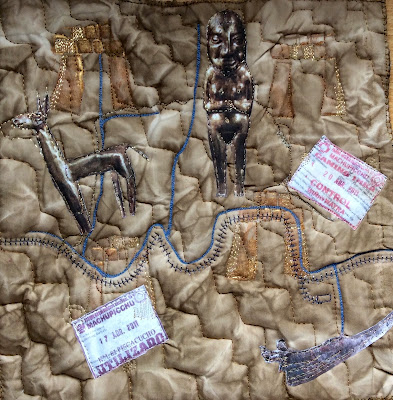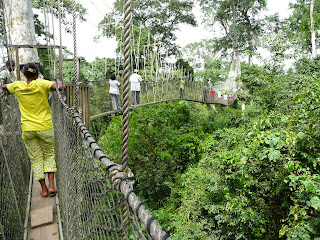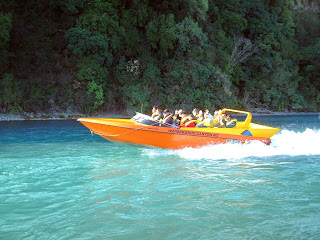I had never quilted before, or so I thought. But actually a lot of the learning so far has entailed elements of quilting without the formality of the three layers and stabilising stitching.
3 Samples;
Sample 1 - flattened areas.
I chose the photo of the Paris eye as the idea for the sample and made a plan for the stitching
Ideas for the first sample
And then stitched on a slightly patterned fabric and colours that complimented the top.
Sample 1
Plain cotton was used as a base and synthetic thick wadding between that and the top fabric. The three layers were stitched to hold them together for stitching as instructed, from the centre to the corners and to each side.
A variegated brown thread was used for granite stitching in the little circles and green variegated thread for the diamonds which were stitched in straight stitching in differing directions to create interest. Then the lines and externals circles were stitched with a bright yellow ad the two lozenge type shapes in bright red thread to take the eye both in and away from the larger circle.
This has an art deco feel to me.
Sample 2- Print and Stitch
I was a bit confused by the instruction for this sample until I saw that the GWR element was a block print!
I decided to use elements of the four day trek to Machu Picchu which I did in 2011 - a photo of the route is one of those in Chapter one resources.
I made a block print (actually a linocut of the symbol used to depict Inca ruins on the map. The top fabric was cotton crushed and dyed with Walnut ink. The result looked mountainous, so it was relevant for the sample.
Between the top layer and a cotton base layer, I used the same synthetic wadding and stitched to secure the sample prior to stitching. The piece was block printed with the linocut and gold acrylic paint.
The river was simply stitched with the rail track running alongside and the walk path in lighter stitching starting alongside the river running vertically to the left and ending at the last block which might denote Machu Picchu. The piece was quilted with stepped stitching with reference to the thousands of Inca steps that we had climbed upland down on the trek.
Tickets and images of artefacts found at the ruins were printed onto printable cotton, backed with Bondaweb and lightly ironed to the piece.
Using the cable stitch method and using a gold thread in the bobbin, I used the stitching lines at the back to highlight the blocks. As the gold behaved very well, I turned the piece over and used the gold on top to highlight other areas and hold the embellishments securely.
Sample 2 - Print and stitch
Sample 3 - a quilted face!
I have quite a collection of faces; I like Green Man but decided to do the self-portrait. Perhaps a mistake in retrospect.
I chose a photo taken recently and from far enough away not to show all the range map lines that have appeared on my face! I only added the really obvious ones - I do which that Botox didn't make such a mask of the face or I might consider having these done....
I used a couple of pieces of calico and two layers of a woolly natural batting between. I admit to not having stitched this piece to secure as it is quite small and was going to have minimal quilting, so I felt that I could hold it taught with my hands. Back thread was used to stitch my very strange face.
Sample 3 - stitched face
Further ideas
I did one more sample, this time using cotton base, synthetic wadding, space dyed muslin, cut up threads, silver paper and bits of synthetic organza as layers then using quilting principles starting at the middle and working outwards I used a tear/leaf like shape and stitched over the piece, adding little bits of detail here and there. Then the piece was worked on with a heat unto burn back to some of the layers
Further sample.
I enjoyed the Machu Picchu sample most of these.














































































